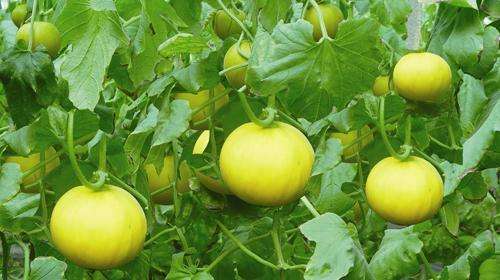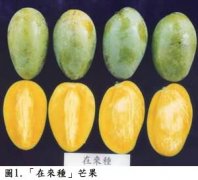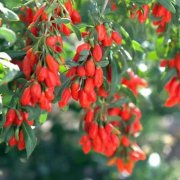Introduction of vertical cultivation techniques of muskmelon, fertilizer dosage and water management methods of muskmelon.
The management technology of vertical cultivation of muskmelon is not difficult, but because the facilities used are expensive, which is much higher than the cost of tunnel cultivation, the average farmer can not bear it, so it becomes an obstacle to large-scale popularization. as a result, its cultivation techniques, field management and pest control of cantaloupe have not been passed on to ordinary farmers.
With the changes of times and the improvement of living standards, increasing yield is no longer the most important consideration in crop cultivation, and how to improve quality in order to increase competitiveness is now the greatest requirement for economically cultivated crops. Cantaloupe produced by vertical cultivation mode has high uniformity in fruit size and beautiful appearance, so it is the best companion for gift-giving.
Key points of cultivation
1. Row-plant spacing: as far as unit area is concerned, it is appropriate to plant 2100-2400 plants per 1000 square meters, which can be planted with reference to the following row-plant spacing according to different cultivation occasions.
1. The method of double-row planting is as follows: the border spacing is 1.8 meters, the row spacing is 90 centimeters, the plant spacing is 40-45 centimeters, and the height of the border is about 30 centimeters.
two。 The method of single-row planting: the border distance is 1.2 to 1.3 meters, the plant distance is 35 to 40 centimeters, and the height of the border is about 30 centimeters.
Fertilizer amount: for soil cultivators, it is appropriate to apply 2000 kg of organic fertilizer, 80kg of Taiwan fertilizer 43 and 40 kg of superphosphate lime on the general soil of 1000 square meters. During the growth period, especially after the pollination period, foliar fertilization is carried out for 2 to 3 times to maintain leaf vitality. At present, there are many commercial brands available, or drip irrigation pipes are embedded to supply water and nutrients.
Third, the application of beneficial microorganisms: inoculating beneficial microorganisms (cyst arbuscular mycorrhizal fungi) during seedling or planting can improve the absorption and utilization of phosphate fertilizer in soil, save the application amount of phosphate fertilizer, and increase the growth potential of the plant. At present, there are many commercial products to choose from, but it should be noted that the use of fungicides should be restricted during the period of inoculation of beneficial microorganisms, so as not to affect the inoculation efficiency of .
Fourth, stay vine, pruning and leading vine: according to the principle of single vine (mother vine) pruning, the mother vine stands upright on the melon net (or pulled by plastic rope), and the side branches or daughter vines that occur below section 10 are removed in advance to promote the growth of mother vines. When the mother vine grows to about 160,200cm, or when the number of the mother vine is 25,28cm, the apical growing point is removed, and the daughter vine occurred in the 11th to 14th nodes is retained, and the rest of the daughter vine is cut off from the bearing place (Earl's variety), or the uppermost 1-2 daughter vine is left with a leaf to remove the heart, and the rest of the daughter vine is also cut off from the birth place (non-Earl's variety). The reserved fruiting branch (cotyledon) the first female flower blossoms on or 1 ~ 2 days before the opening, the cotyledon leaves are left to pick the heart to promote the development of the female flower, and the aged leaves at the base are trimmed together to facilitate ventilation. The whole plant type has more than 20 mature leaves and at least 14 mature leaves at the upper end of the fruit branch. if the selected variety is not Earl's system, the upper end of the plant should keep 1-2-shoot sun vine to maintain the plant potential is not easy to premature senescence.
5. Pollination and fruiting:
1. Pollination bees sold commercially can be used to assist in pollination. Move the pollination beehive into the facility three days before flowering, so that the colony can adapt to the environment. 2000 million bees are needed for every 1000 square meters (about 4 pieces per box). The pollination period of the same batch of plants is about 5 to 7 days.
two。 If the weather is a continuous overcast and rainy day, the colony activity weakens, or if the unit area is small and does not need to be pollinated by bees, it must be done by artificial pollination. Pollination can achieve the maximum effect when pollination is completed from dawn to 9 o'clock in the morning.
3. It is not suitable to use growth hormone: although many fruit promoters have been developed commercially, because the application of these agents can easily lead to uneven fruit hypertrophy, the net pattern of muskmelon is not easy to reach the grade of high-grade products, and the sugar content is slightly reduced. therefore, it is not recommended to be used in the production of high-grade products.
6. fruit retention, hanging fruit and bagging: 5-7 days after successful pollination, the young fruit has developed about the size of an egg (fruit length 4-7 cm). At this time, those with good development, appearance and fruit shape are selected to hang from the pedicel on the melon net with a hook, or a plastic rope is tied from the stalk to the crossbar of the facility, and the rest of the fruit is cut off after the selected fruit has been suspended. Attention should be paid to the perpendicular angle between the daughter vine and the mother vine when hanging the fruit, so as to facilitate the transport of nutrients and moisture. It is best to do fruit thinning in the morning on sunny days and avoid operation on cloudy and rainy days. Bagging can not only prevent epidermis hardening and fruit drying caused by excessive light, but also prevent the solution from sticking to the peel, making the color of the peel more beautiful. In application, the effects of shading, moisturizing and air permeability can be achieved by using old newspapers.
7. Water management: soil tillage growers should provide sufficient water when planting to ensure the smooth survival of young plants; soil moisture should be gradually reduced near flowering stage, which is beneficial to flowering and fruiting; water demand during the development period of small fruit increases, and adequate water supply is conducive to the full development of fruit; to be observed at the beginning of cracks, attention should not be paid to excessive moisture, so as not to affect the appearance of cracks. After the formation of stable reticulation, water supply can slightly increase the soil water content, so that the fruit can grow to its proper size, and then control the soil to maintain low water content in order not to wither the plant.
8. Harvest: when recording the flowering period and calculating the number of mature days or observing the yellowing phenomenon of magnesium deficiency in the leaflets on the remaining vines of healthy plants, 1-2 fruits were selected to test their sugar accumulation in order to allocate the harvest time. When harvesting, a T-shaped pedicel is left at the head to improve beauty.

- Prev

The methods of field management after mango cultivation and harvest, and what matters should be paid attention to during mango pruning.
Do you know Taiwan mango soil mango? According to the calendar of cultivation in Taiwan, the harvest time of mango is about May to October. During this period, the farmers' hard work for a year finally paid off. However, just one or two months after fruit harvest is an important key to mango production in the future.
- Next

What is the breeding method of Chinese wolfberry? How to deal with the care leaves of Chinese wolfberry with white powder?
Potted Chinese wolfberry like to grow warm in the pot not only good-looking leaves and fruits (wolfberry) can eat, pruned old branches can also be boiled into tea to drink! Most of the potted flowers in Xiaoman's backyard only put coffee grounds and fallen leaves in a mixture of soil and organic compost.
Related
- The first cup of black tea in spring, the flavor and history of tea gardens in Kenya, Africa
- The computer can not only choose potatoes, but also grow tea rice. AI will grow winter oolong tea champion.
- It is not only the inflated tea bitten by insects, but also engraved with the four seasons tea in Beipu.
- The Oriental Beauty Tea Festival in Zhuxian County takes the stage at the weekend to experience the plus-size feast of oil tea.
- & quot; Oriental Beauty Tea & Exploration of Emei in Hsinchu, the hometown of quot;
- The new variety of strawberry "Tainong 1" dessert is the first choice with mellow aroma. Crimson gorgeous
- History of Tea in Taiwan: from Wild Inner Mountain to Export Tea Garden
- Two types of Taiwan Oriental Beauty Black Tea won the British three-Star Award for Childhood Tea Xiang Zhang Jiaqi changed from pilot to champion tea maker.
- Banana species and varieties: the planting history of Taiwan Xianren banana and dwarf banana is long, is banana disease resistant?
- Coffee planting Technology: Qianjie Coffee from Seedling to harvesting

